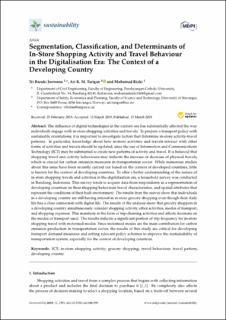| dc.contributor.author | Joewono, Tri Basuki | |
| dc.contributor.author | Tarigan, Ari Krisna Mawira | |
| dc.contributor.author | Rizki, Muhammad | |
| dc.date.accessioned | 2023-01-24T14:35:02Z | |
| dc.date.available | 2023-01-24T14:35:02Z | |
| dc.date.created | 2019-03-15T12:40:50Z | |
| dc.date.issued | 2019 | |
| dc.identifier.citation | Joewono, T. B., Tarigan, A. K., & Rizki, M. (2019). Segmentation, classification, and determinants of in-store shopping activity and travel behaviour in the digitalisation era: the context of a developing country. Sustainability, 11(6), 1591. | en_US |
| dc.identifier.issn | 2071-1050 | |
| dc.identifier.uri | https://hdl.handle.net/11250/3045926 | |
| dc.description.abstract | The influence of digital technologies in the current era has substantially affected the way individuals engage with in-store shopping activities and travels. To prepare a transport policy with sustainable orientations, it is important to investigate factors that determine in-store activity-travel patterns. In particular, knowledge about how in-store activities and travels interact with other forms of activities and travels should be updated, since the use of Information and Communications Technology (ICT) may be substantial to create new patterns of activity and travel. It is believed that shopping travel and activity behaviours may indicate the increase or decrease of physical travels, which is crucial for carbon emission measures in transportation sector. While numerous studies about this issue have been recently carried out based on the context of developed countries, little is known for the context of developing countries. To offer a better understanding of the nature of in-store shopping travels and activities in the digitalisation era, a household survey was conducted in Bandung, Indonesia. This survey tends to acquire data from respondents as a representation of developing countries on their shopping behaviour, travel characteristics, and spatial attributes that represent the conditions of their built environment. The results from the survey show that individuals in a developing country are still having interest in in-store grocery shopping even though their daily life has a close connection with digital life. The results of the analysis show that grocery shoppers in a developing country simultaneously consider shopping activity, other activities, modes of transport, and shopping expenses. This manifests in the form of trip-chaining activities and affects decisions on the modes of transport used. The results indicate a significant portion of trip frequency for in-store shopping travel with motorised modes. Since motorised modes are the main contribution for carbon emission production in transportation sector, the results of this study are critical for developing transport demand measures and setting relevant policy schemes to improve the sustainability of transportation system, especially for the context of developing countries. | en_US |
| dc.language.iso | eng | en_US |
| dc.publisher | MDPI | en_US |
| dc.rights | Navngivelse 4.0 Internasjonal | * |
| dc.rights.uri | http://creativecommons.org/licenses/by/4.0/deed.no | * |
| dc.title | Segmentation, Classification, and Determinants of In-Store Shopping Activity and Travel Behaviour in the Digitalisation Era: The Context of a Developing Country | en_US |
| dc.type | Peer reviewed | en_US |
| dc.type | Journal article | en_US |
| dc.description.version | publishedVersion | en_US |
| dc.rights.holder | The authors | en_US |
| dc.subject.nsi | VDP::Samfunnsvitenskap: 200 | en_US |
| dc.source.pagenumber | 23 | en_US |
| dc.source.volume | 11 | en_US |
| dc.source.journal | Sustainability | en_US |
| dc.source.issue | 6 | en_US |
| dc.identifier.doi | 10.3390/su11061591 | |
| dc.identifier.cristin | 1685051 | |
| cristin.ispublished | true | |
| cristin.fulltext | original | |
| cristin.qualitycode | 1 | |

